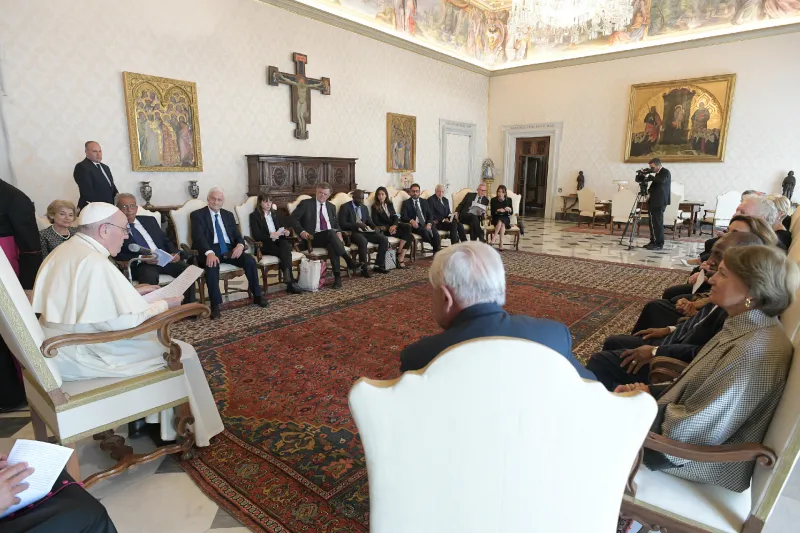
Vatican City, Sep 4, 2021 / 07:05 am (CNA).
Pope Francis said Saturday that politics needs a renewal after the pandemic through the promotion of a culture that prioritizes human dignity.
“The pandemic, with its long aftermath of isolation and ‘social hypertension,’ has inevitably also challenged political action itself, politics as we know it,” Pope Francis said on Sept. 4.
“It is therefore a question of working simultaneously on two levels: cultural and institutional,” he said.
The pope told members of the organization, Leaders Pour la Paix (Leaders for Peace), that helping others to understand the root causes of problems can be considered an “education for peace.”
“It is important to promote a ‘culture of faces,’ which places the dignity of the person at the center, a respect for his or her story, especially if they are wounded and marginalized,” he said in an audience with the group at the Vatican.
“It is also a ‘culture of encounter’ in which we listen to and welcome our brothers and sisters, with trust in the reserves of good that are in the hearts of the people.”
Leaders Pour la Paix is an organization founded by the former French Prime Minister Jean-Pierre Raffarin that brings together high-level government representatives from around the world.
U.S Secretary of State Antony Blinken and Ban Ki-moon, former secretary-general of the United Nations, are among the its board of leaders, along with Kamal Kharazi, the former Iranian foreign minister, and Quan Kong, a member of the Central Committee of the Chinese Communist Party.
The group of 36 world leaders aims to reduce conflicts through prevention by alerting public opinion and decision-makers on risky situations and their consequences, according to its website.
.png) Pope Francis meets with members of Leaders Pour la Paix. Vatican Media/CNA
Pope Francis meets with members of Leaders Pour la Paix. Vatican Media/CNAPope Francis encouraged the members of the organization to pursue peace through multilateral institutions.
“It is urgent to encourage dialogue and multilateral collaboration, because multilateral agreements better guarantee the protection of a truly universal common good and of the weakest states than bilateral ones,” he said.
The pope underlined that this is “a particularly critical historical moment” in which the pandemic has not yet been overcome and its economic and social consequences are weighing heavily on “the lives of the poorest.”
“Not only has it impoverished the human family of many lives, each one precious and unrepeatable; it has also sown much desolation and increased tensions,” Francis said.
“Faced with the worsening of multiple converging political and environmental crises – hunger, climate, nuclear weapons to name a few – your commitment to peace has never been so necessary and urgent.”
If you value the news and views Catholic World Report provides, please consider donating to support our efforts. Your contribution will help us continue to make CWR available to all readers worldwide for free, without a subscription. Thank you for your generosity!
Click here for more information on donating to CWR. Click here to sign up for our newsletter.




All good points globally, and timely. And yet, within the Church we have thought that the troubling theme was the rupture between the “hermeneutics of continuity” and the “hermeneutics of discontinuity.” Too academic!…
Instead, is the internal ordeal the difference between the Church, itself, and willful ignorance at the mercy (!) of clericalist handlers? Have we been distracted too much by the machinations of McCarrick who simply happened to be a poster-child sexual abuser as well?
What about the well-placed coven of, shall we say “ecclesial abusers,” who apparently have shaped and even determined papal perceptions and commentary for eight long years? This apparently without the interference of any written or broadcast news and analysis, or even computer access by the pope? Who are these alleged whisperers, these news filterers and ghost writers, and what are they saying?
Check out the “ten takeaways” from Pope Francis’ recent interview, as identified by Fr. Raymond de Souza: https://www.ncregister.com/commentaries/ten-takeaways-from-pope-francis-latest-interview?
Afterthought:
There are 439 million cell phone users in India. That’s one out of every two persons above the age of 15. Statistical chances are that nearly 100% that the rural family (husband and wife), responsible for only a small crop and some chickens, have a cell phone and greater independent access to internet information than does the pope, the shepherd of 1,400 million followers.
Pope Pius IX once said correctly of incommensurate goods, that “a single human soul is worth more than all the railroads in Italy.” But, considering today’s challenges and the Information Highway, this attitude raises a red flag. or is it rainbow-colored?
No wonder that after eight years, none of the inner circle have even thought to offer Pope Francis a five-minute tutorial on computer use. Can’t risk complicating the agenda.